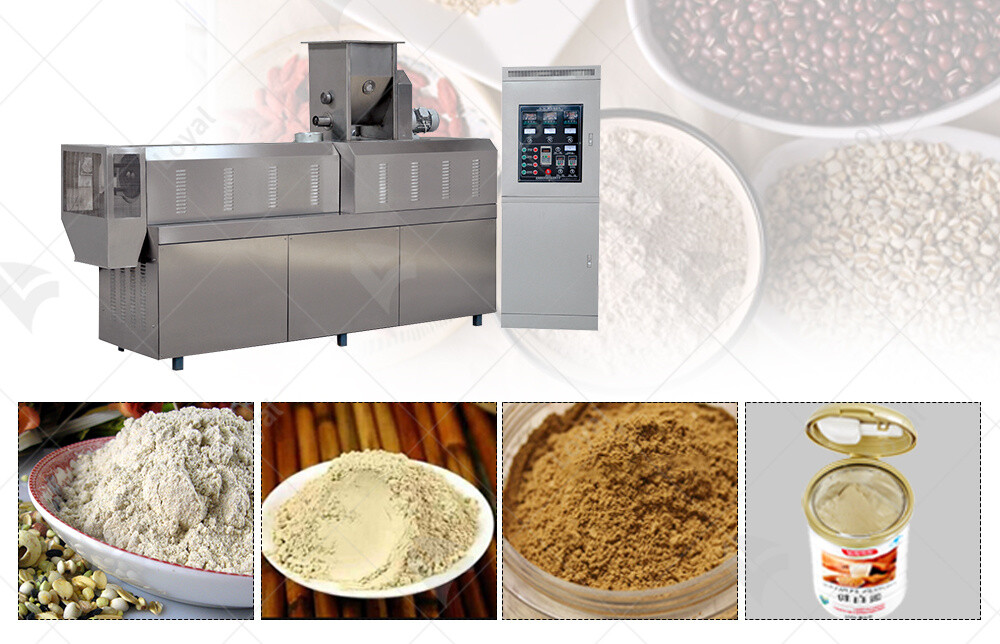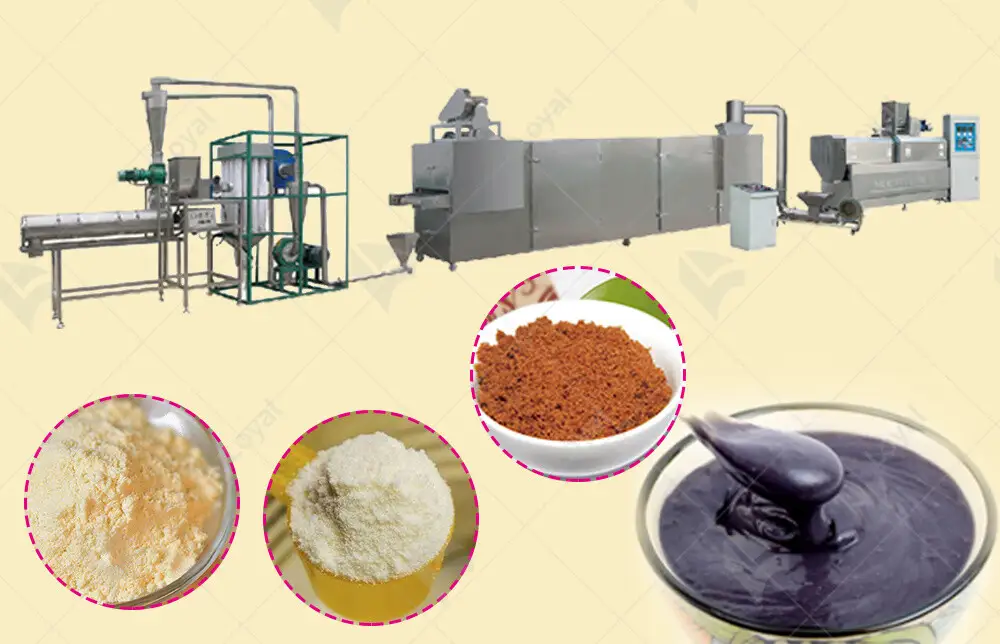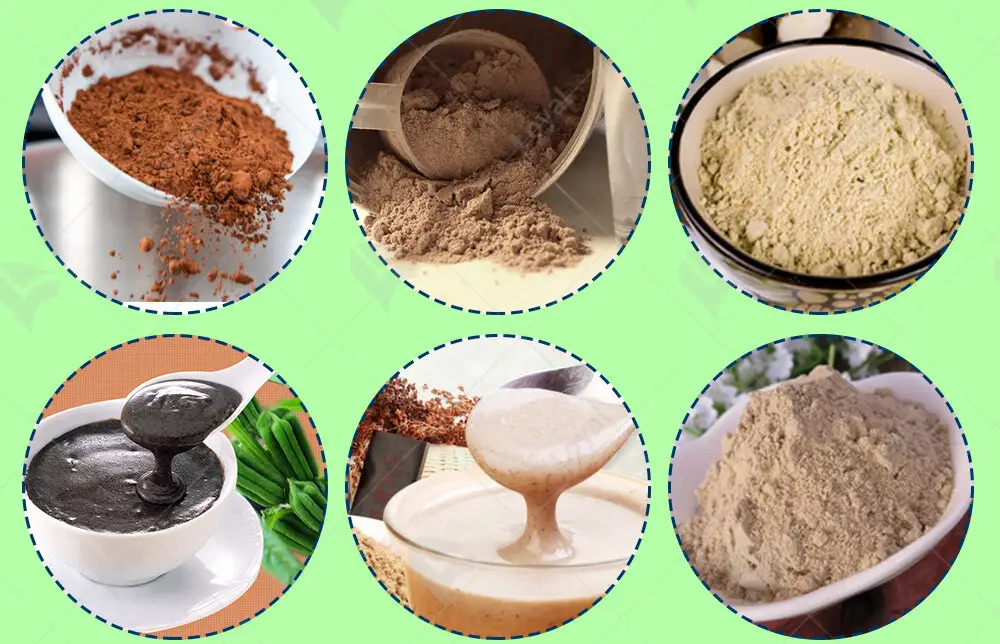Unlock The Secret To Nutritional Baby Rice Powder Food Processing Line
Introduction
Unlocking the secrets to the Nutritional Baby Rice Powder Food Processing Line unveils a specialized realm within industrial food machinery. Designed meticulously to meet the exacting standards of nutritional integrity for baby food products, these processing lines embody precision and innovation.
At the heart of every Nutritional Baby Rice Powder Food Processing Line lies a sophisticated amalgamation of cutting-edge technology and stringent regulatory compliance. This ensures not only the nutritional efficacy but also the safety and quality paramount for infant consumption.
As experts in industrial food machinery, we delve into the pivotal role these processing lines play in the production of baby rice powder. From meticulous formulation to the seamless integration of machinery components, each step is orchestrated to deliver optimal nutritional value while adhering to global safety standards.
Join us on this journey as we uncover the nuances and innovations that define the landscape of Nutritional Baby Rice Powder Food Processing Line, setting benchmarks in nutritional excellence and technological advancement.

Nutritional Content Essential for Baby Rice Powder
In the realm of Nutritional Baby Rice Powder Food Processing Line, understanding the essential nutritional content is paramount. Baby rice powder serves as a crucial early food source, requiring meticulous formulation to meet the developmental needs of infants.
Key Nutrients: The formulation of baby rice powder involves careful consideration of key nutrients such as carbohydrates, proteins, fats, vitamins, and minerals. Each nutrient plays a vital role in supporting the growth and development of infants, ensuring they receive adequate nutrition during their formative months.
Importance of Balance: Achieving a balance of nutrients is critical to meet regulatory standards and provide infants with a wholesome diet. Components like iron, essential for cognitive development, and calcium for bone growth, are meticulously incorporated into the processing line to maintain nutritional integrity.
Quality Assurance: In Nutritional Baby Rice Powder Food Processing Lines, quality assurance protocols ensure that each batch meets stringent nutritional guidelines. From raw material selection to final packaging, every step adheres to industry-best practices to guarantee safety and efficacy.
Technological Integration: Advanced technologies within these processing lines facilitate the precise measurement and incorporation of nutrients. Automation and monitoring systems ensure consistency and accuracy, minimizing variations in nutritional content across production batches.
Future Trends: The future of Nutritional Baby Rice Powder Food Processing Lines lies in continuous innovation. Emerging trends focus on enhancing nutrient bioavailability and sustainability, driving the industry towards higher nutritional standards and eco-friendly practices.

Benefits of using specialized processing lines
Benefits | Details |
| Enhanced Nutritional Precision | Ensures precise control over ingredient ratios, optimizing nutritional content such as proteins, vitamins (e.g., vitamin D, vitamin E), and minerals (e.g., iron, calcium) crucial for infant development. This precision is achieved through advanced mixing and blending technologies, ensuring uniform distribution of nutrients throughout the product. |
| Improved Safety and Hygiene Standards | Integrated sanitation systems and hygienic design minimize contamination risks, adhering to stringent safety standards (e.g., ISO 22000, HACCP). These systems include automated cleaning processes, stainless steel construction to prevent bacterial growth, and controlled environments that reduce the risk of cross-contamination, ensuring the safety of the final product for infant consumption. |
| Increased Production Efficiency | Automation in specialized processing lines streamlines production processes, reducing manual handling and human error. This efficiency results in higher throughput rates and consistent product quality, meeting the increasing demand for nutritional baby rice powder in the market effectively. |
| Regulatory Compliance Assurance | Specialized processing lines incorporate built-in monitoring and control systems that ensure compliance with regulatory requirements (e.g., FDA regulations, EU food safety directives). These systems track critical parameters such as temperature, pressure, and ingredient ratios, providing documentation and audit trails necessary for regulatory audits and certifications. |
| Innovation in Formulation and Packaging | Technological advancements in specialized processing lines enable continuous innovation in nutrient formulation and packaging solutions. Formulation innovations focus on enhancing nutrient bioavailability and meeting specific dietary needs of infants, while packaging innovations include eco-friendly materials and designs that maintain product freshness and appeal to environmentally conscious consumers. These innovations keep manufacturers competitive in the dynamic market landscape of nutritional baby food products. |

Key Components of a Nutritional Baby Rice Powder Food Processing Line
In the domain of industrial food machinery, the Nutritional Baby Rice Powder Food Processing Line comprises essential components that are pivotal in ensuring the production of safe, nutritious baby rice powder.
1. Mixing and Blending Systems:
Purpose: These systems are crucial for achieving uniform blending of ingredients such as rice, vitamins, and minerals.
Significance: Ensures consistent nutritional composition throughout the product, meeting infant dietary requirements effectively.
2. Extrusion and Forming Equipment:
Function: Shapes the rice powder into various forms such as flakes or granules suitable for infant consumption.
Importance: Controls texture and aids in the easy preparation of rice powder for feeding infants.
3. Drying and Sterilization Units:
Role: Removes moisture from the product to extend shelf life and sterilizes to ensure microbiological safety.
Criticality: Maintains nutritional integrity while safeguarding against contaminants, meeting stringent health standards.
4. Packaging Machinery:
Purpose: Efficiently packages the processed baby rice powder into consumer-friendly units.
Impact: Preserves product freshness and ensures hygiene, crucial for safe consumption by infants.
5. Quality Control and Monitoring Systems:
Functionality: Monitors and controls critical parameters such as temperature and moisture levels.
Assurance: Ensures consistency in product quality and compliance with regulatory requirements, guaranteeing safety for infant consumption.
6. Automation and Control Systems:
Automation: Automates production processes to minimize human intervention and optimize efficiency.
Control: Provides precise control over processing variables, enhancing productivity and maintaining product consistency.
These key components collectively form the backbone of a Nutritional Baby Rice Powder Food Processing Line, integrating advanced technology and stringent quality control measures to produce high-quality, safe, and nutritious baby food products.

The Science Behind Nutritional Formulation for Baby Rice Powder
In the realm of industrial food machinery, particularly in the production of Nutritional Baby Rice Powder, the formulation process involves intricate scientific principles to ensure the product meets the nutritional needs of infants effectively.
1. Ingredient Selection and Nutrient Balance:
Purpose: Selecting high-quality rice and supplementary ingredients rich in essential nutrients such as proteins, vitamins (e.g., vitamin D, vitamin E), and minerals (e.g., iron, zinc).
Importance: Achieving a balanced nutrient profile critical for infant growth and development, emphasizing optimal cognitive and physical health.
2. Processing Techniques and Nutrient Retention:
Techniques: Utilizing gentle processing methods to preserve heat-sensitive nutrients.
Retention: Ensuring minimal nutrient loss during processing stages such as milling, extrusion, and drying, maintaining nutritional integrity.
3. Fortification and Bioavailability Enhancement:
Fortification: Enhancing nutritional value through fortification with micronutrients crucial for infant health, adhering to regulatory standards.
Bioavailability: Ensuring nutrients are in forms easily absorbed by infants' delicate digestive systems, maximizing nutrient utilization.
4. Quality Control and Assurance:
Monitoring: Implementing stringent quality control measures to verify nutrient content and product consistency.
Assurance: Conducting thorough testing for contaminants and allergens, ensuring safety and compliance with food safety regulations.
5. Innovation in Formulation:
Research and Development: Continuously innovating formulations based on scientific research and consumer insights.
Adaptability: Responding to emerging nutritional trends and consumer preferences, enhancing product relevance and appeal.
6. Consumer Safety and Trust:
Transparency: Providing clear nutritional information on product labels, fostering consumer trust and confidence in product safety and efficacy.
Regulatory Compliance: Adhering to local and international regulations governing infant food products, ensuring product legality and safety.
The formulation of Nutritional Baby Rice Powder is a precise blend of science and technology, driven by a commitment to producing safe, nutritious products that support the healthy development of infants worldwide.

Process Flow in Nutritional Baby Rice Powder Production
In the domain of industrial food machinery, the production process for Nutritional Baby Rice Powder involves several precise steps to ensure high nutritional value and safety for infant consumption.
1. Raw Material Handling and Preparation:
Handling: High-quality rice and supplementary ingredients are sourced and inspected for purity and nutritional content.
Preparation: Raw materials undergo cleaning, soaking, and sometimes sprouting to enhance digestibility and nutrient availability.
2. Milling and Grinding:
Milling: Rice is milled into fine particles to achieve desired texture and consistency.
Grinding: Additional grinding may be used to further reduce particle size, ensuring smoothness in the final product suitable for infant consumption.
3. Mixing and Blending:
Mixing: Precise blending of rice powder with vitamins, minerals, and other additives to achieve the desired nutritional profile.
Homogenization: Ensures uniform distribution of nutrients throughout the mixture, critical for consistent nutritional content in every serving.
4. Extrusion and Shaping:
Extrusion: The blended mixture is extruded into specific shapes such as flakes or granules.
Shaping: Shapes are formed to facilitate easy reconstitution with water, catering to the needs of infants transitioning to solid foods.
5. Drying and Sterilization:
Drying: Products are dried using controlled temperatures to remove moisture while preserving nutrients.
Sterilization: Ensures the product is free from harmful microorganisms, extending shelf life and maintaining product safety.
6. Packaging and Quality Control:
Packaging: Automated systems package the dried and sterilized rice powder in hygienic containers or pouches.
Quality Control: Continuous monitoring of product quality throughout the production process, including final product inspection for consistency and compliance with safety standards.
7. Storage and Distribution:
Storage: Finished products are stored in controlled environments to maintain freshness and nutritional integrity.
Distribution: Efficient logistics ensure timely delivery to retailers and consumers, meeting demand for high-quality infant nutrition products.
The process flow in Nutritional Baby Rice Powder Production integrates advanced technology with stringent quality control measures, ensuring safe and nutritious products that support infant health and development.

Innovations and Technologies Driving Nutritional Baby Rice Powder Food Processing Line
The field of nutritional baby rice powder food processing has seen remarkable advancements driven by cutting-edge technologies. These innovations not only enhance production efficiency but also ensure the highest standards of safety and nutritional quality for infants worldwide.
Advanced Mixing and Formulation
At the heart of the nutritional baby rice powder food processing line lies advanced mixing and formulation technologies. These systems are designed to blend rice, vitamins, minerals, and essential nutrients with unparalleled precision. Each component is carefully measured and mixed to exacting specifications, ensuring consistency in every batch. This precision is crucial for meeting the nutritional needs of infants, supporting their growth and development.
Hygienic and Sterile Processing Environment
Ensuring the safety and purity of infant food products is paramount. The processing line incorporates state-of-the-art hygienic practices and materials to maintain a sterile environment throughout production. From initial ingredient handling to final packaging, every step adheres to rigorous sanitation standards. This commitment minimizes the risk of contamination and ensures that each product meets the highest safety benchmarks.
Automated Packaging Solutions
Efficiency in packaging is achieved through sophisticated automated systems. These systems handle the entire packaging process, from filling and sealing to labeling and palletizing. Automation not only speeds up production but also reduces human error, ensuring that products are securely packaged and ready for distribution. This streamlined approach enhances overall operational efficiency while maintaining product integrity.
Quality Control and Assurance
Quality control is rigorously enforced at every stage of the processing line. Advanced sensors and monitoring devices continuously evaluate key parameters such as moisture content, particle size, and nutritional composition. Real-time data analysis allows for immediate adjustments, ensuring that each batch meets strict quality standards. This commitment to quality assurance guarantees consistency and reliability in every nutritional baby rice powder product.

Reference
The following are five authoritative foreign literature websites on industrial Nutrirional Powder production:
1.Science.gov
Website: [https://www.science.gov]
2.Data.gov
Website: [https://www.data.gov]
3.SpringerLink
Website: [https://link.springer.com/]
4.WorldWideScience.org
Website: [https://www.worldwidescience.org]
5.DOAJ (Directory of Open Access Journals)
Website: [https://www.doaj.org]












